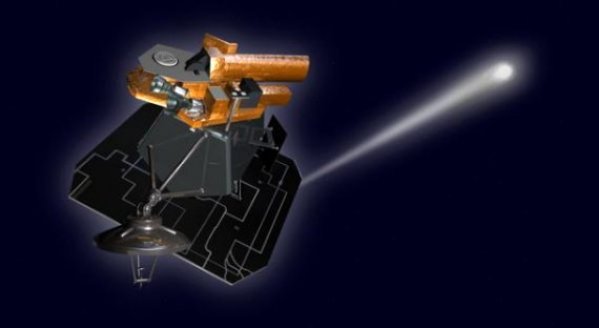
Deep Impact spacecraft on the approach to comet Hartley 2 in early November. (Photo: NASA).
According to astronomers, comet Hartley 2 and Earth will have a close encounter this month.

In a year, a dozen comets often approach the Earth in a distance that amateur telescopes can capture. Most come and go quietly. However, in the next few weeks, a small comet will approach Earth at an unusually close distance.
Specifically, on October 20, comet Hartley 2 will move to a point about 17.7 million kilometers from Earth. Thus, during this month, the comet can be viewed easily with a small telescope, binoculars and even using the naked eye in some dark places to see the night sky clearly.
Comets are a collection of ice, dust, ice and frozen gases like carbon monoxide (CO), methane and ammonia. Due to the low density, the comet's nucleus does not form a cube like larger objects in the universe, and therefore it is often irregular.
They are always described as ' dirty snow handles ', although recent observations show that they have a surface full of dry dust or jagged rock, indicating that the ice is hidden beneath the crust.
In addition to approaching Earth, comet Hartley 2 will be visited by the Deep Impact spacecraft in early November. Previously, it also arrived at Comet Tempel 1 in 2005.
Hartley's discovery
On March 15, 1986, astronomer Malcolm Hartley discovered a new comet thanks to the telescope image taken by UK Schmidt in Siding Spring, Australia.
By the time Hartley discovered the comet, it was just a very faint thing in the sky. Its light is more than 25,000 times dimmer than the weakest starlight that the naked eye can see.
After studying the pictures taken a few days later, Hartley announced his discovery at the Astronomical Information Processing Center in Cambridge, Massachusetts (USA).
This is the second time Hartley has discovered a comet, so the name of the comet has been named comet Hartley 2.
The Smithsonian Astrophysical Observatory calculated its orbit and determined that comet Hartley 2 had the closest approach to the sun 9 months ago. 4 years earlier, this comet also approached Jupiter. Comet Hartley 2 takes about 6 and a half years to move around the sun. Since then, it has reappeared in 1991, 1997 and 2004.

Hartley 2 was an important target of the Deep Impact spacecraft. (Illustration).
Rare access
This fall, comet Hartley 2 will once again move across the solar system, reaching the closest distance to the sun on October 28, approximately 158 million kilometers. While moving near the sun, it will reach a very close distance to the Earth. It is expected that at 3 pm on October 20 (ET time), the comet will be only about 18 million kilometers from Earth.
The fact that a comet is at such a close distance to Earth is extremely rare, occurring only about 3 to 4 times in a century.
Unfortunately, comet Hartley 2 is small and weak. The Spitzer space glass once sent to Earth the image of this comet in August 2008, in which its center is about 1.12 km in diameter, only 1/10 of Hartley comet and 1/30 comet Hale-Bopp . However, because of moving too close to Earth, comet Hartley 2 is still visible to the naked eye from the first half of October in areas where the night sky is visible.
Astronomers often use apparent brightness (of celestial bodies) to determine the brightness of objects in the sky; The lower this brightness, the brighter the object. The brightest stars have an apparent brightness of 0 or 1, while the faintest star is at 6.
According to calculations, comet Hartley 2 will have an apparent brightness of 4.4 during the closest approach to Earth.